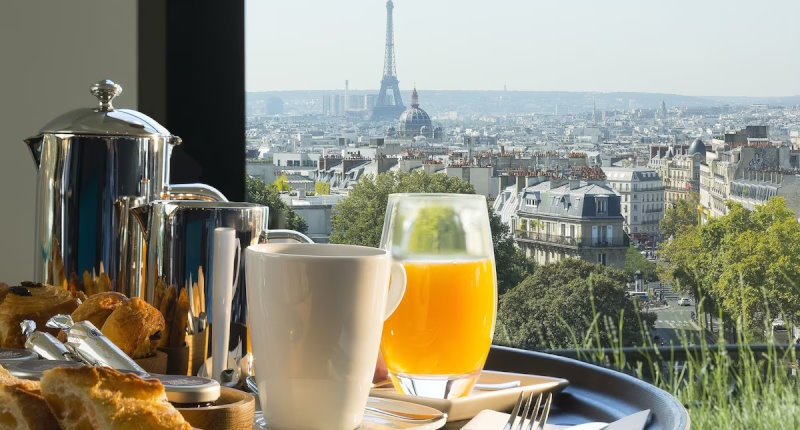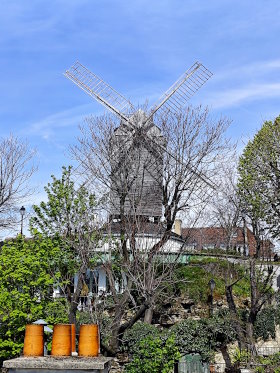Le Moulin de la Galette windmill in Montmartre

Le Moulin de la Galette in Montmartre is the best known traditional ancient windmill in France. This windmill was made famous by 1876 Renoir painting "Dance at Le Moulin de la Galette", now in Musée d'Orsay in Paris. A guinguette when Auguste Renoir painted it, it now hosts the Moulin de la Galette restaurant. Montmartre top sights.
Moulin de la Galette Paris facts
The Moulin de la Galette is a traditional ancient windmill in Montmartre. 19th owners, the Debray family, made a brown bread, called galette, which became popular and gave its name to the windmill.
This traditional windmill was associated with a guinguette, a type of popular tavern. The guinguette was a diversion for Parisians seeking entertainment, a glass of wine and bread made from flour ground by the windmill.

Moulin de la Galette is a top Montmartre sight
Windmill restaurant Montmartre
Le Moulin de la Galette restaurant is a gastronomic restaurant housed in Le Moulin de la Galette traditional windmill. Close to Sacré-Coeur and Place du Tertre, it is one of the good restaurants in Montmartre. You can see the interior of the mill over the bar. Locate Moulin de la Galette on Montmartre map. Paris metro: Abbesses (line 12) and Anvers (line 6).
Paris 75018 France

Moulin de la Galette is a windmill restaurant
Stay in Montmartre hotel with rooftop terrace and Paris view

Montmartre hotel
Located in Montmartre, Timhotel Montmartre provides rooms with free Wi-Fi access, flat-screen TVs and private bathrooms. A buffet breakfast is served daily at the Timhotel Montmartre. The hotel also provides a 24-hour reception, where guests can request hairdryers and ironing facilities. The Timhotel Montmartre is a 5-minute walk from the Sacré-Coeur Basilica, the Moulin Rouge and the Dali Museum. It is 100 m from Abbesses Metro Station, which provides direct access to Montparnasse.
Paris 75018 France

View from Timhotel in Montmartre
Traditional ancient windmills in Montmartre
In 1740, there were up to 12 ancient traditional windmills in the middle of the vineyards of Montmartre Hill. Built from 1529, they were destroyed one by one between 1758 and 1854. The Blute-Fin and the Radet are the two remaining ancient traditional windmills in Montmartre. They formed together the famous Moulin de la Galette ensemble, with its popular ball and guingette.
The Blute-Fin was mentioned for the first time in 1622 under the name of Moulin du Palais. It became part of the Debray family properties in 1809 and made flour. Transformed into a tavern in 1834, it took the name Moulin de la Galette in 1895. It is now a private property. The name “Blute-fin” comes from the verb “bluter” which means to sift the flour to separate it from the bran.
The Radet mill was mentioned for the first time in 1717. In 1915, the old mill, threatened with demolition, was saved by the mobilization of Parisians. Its owner, Pierre-Auguste Debray, offered it to the Vieux Montmartre society on the condition that it be transferred to another location. The Moulin de la Galette restaurant occupies the ground floor.

The Blute-fin windmill is now a private property
Moulin de la Galette detailed history
When they got the two mills on rue Lepic, the “Blute-fin” and the “Radet”, in 1809, the Debray family was far from suspecting that their little corner of the Montmartre countryside would become a legend. At that time, the Montmartre district was not yet part of the municipality of Paris. Between them stood the wall of the Fermiers Généraux. However, this did not prevent Parisians from going there to enjoy a stroll in the fresh air and taste, on the way, the succulent galettes of Mère Debray. Made from rye flour directly extracted from the mill, these rolls were eaten with a glass of milk, and soon, a glass of local wine, pressed under the Debray millstones.
In 1834, the Debray mills saw their activity falter in the face of competition and were therefore converted into a popular ballroom. First known as Bal Debray, it changed its name in 1895 to “le Moulin de la Galette”. Success was immediate! Every Sunday and public holiday, customers flocked there to dance the polka, the quadrille, the chahut, the cancan and the French-cancan. First an open-air guinguette, a closed ballroom was subsequently built, near the Radet. From the 1900s, the Moulin de la Galette gained popularity and very quickly became the favorite haunt of many celebrities.
The Guinguette having had its day, the ballroom hosted, in the middle of the 20th century, a music hall, then television and radio sets. The mill was restored in 1978, but would never be used again. Listed as a historical monument in 1958, it is considered, to this day, as the last working windmill in Paris.
Moulin de la Galette paintings
Dance at Le Moulin de la Galette by Pierre-Auguste Renoir is one of Impressionism's celebrated masterpieces. It depicts a typical Sunday afternoon at the Moulin. In the late 19th century, working class Parisians would dress up and spend time there dancing, drinking, and eating into the evening. The painting is now in Musée d'Orsay. Moulin de la Galette is also the title of several paintings of the windmill made by Vincent van Gogh in 1886. The Moulin de la Galette was near the apartment in Montmartre where the pennyless Vincent Van Gogh lived with his brother Theo.

Moulin de la Galette was painted by Van Gogh
Moulin de la Galette painting by Auguste Renoir
Executed in 1876, Auguste Renoir's Moulin de la Galette, now inMusée d'Orsay, is probably the best-known work of the French painter today. In 1877, the painting was presented on the occasion of an exhibition organized by the Impressionist group. Already at that time, the work surprised by its representation of the entertaining and friendly atmosphere of a high place of popular life. from the capital: the Moulin de la Galette, a well-known establishment on the Butte Montmartre, very popular in the second half of the 19th century.
By choosing a subject rooted in the Parisian life of his time, Renoir at the same time used a most innovative pictorial style applied to a very imposing canvas format. His painting, a sign of great ambition in the process, attempts to represent a crowd in motion, quivering, passing from one table to another, dancing to the sound of music or chatting in small groups.
The style, with touches of shadow and clarity, restores natural and artificial light with an infinite sense of detail. These same touches of light seem to be very mobile, as they are arranged on the white floor, on the dresses of women or on the cheeks of young children. By using delicate, pastel shades, such as blue, pink and beige, Renoir infuses a lot of lightness into his creation.
The large number of characters witnesses to the breath of gaiety and lightness of life which then agitated the streets and establishments of the Montmartre hill. The composition remains perfectly balanced, mainly thanks to a particularly visible diagonal separating the foreground from the background, coming to demarcate a clear distinction between the groups of drinkers seated at the tables and the dancers who gather in front of the stage. This gathering of people serves the impression of boiling that emanates from it. Light colors, ribboned hats, smiling faces, One would think we could see this crowd fluttering before our eyes. A sensation reinforced by the colors which have been applied in visible, free and almost sensual touches, piercing through the branches of the trees and therefore following the patterns composed by their foliage.